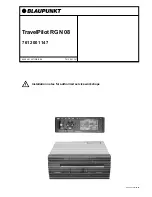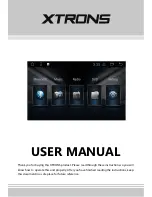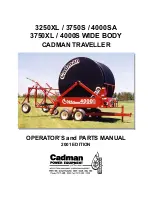
- 4 -
If necessary, use protective sheathing to protect the antenna
cable from being pinched.
The adherent surface of the antenna must be free of dirt, snow,
ice, etc.
You must not lengthen, shorten or put a kink in the antenna
cable. Do not remove the plug during the installation.
If the antenna is painted the same colour as the vehicle, this
may have an adverse effect on the reception, especially if paints
containing a high percentage of metal are used. We assume
no guarantee that the antenna will operate properly after it has
been painted.
On notchback vehicles, attach the antenna to the boot lid using
the mounting brackets. Depending on the thickness of the metal,
use the corresponding headless screws, Fig. 2.
On estate and hatchback cars, affix the antenna to the roof
with its magnetic foot, Fig. 3.
For a roof mount, remove the mounting brackets. Use the ad-
hesive strips enclosed to cover the screw holes, Fig. 4.
For estate and hatchback cars, lay the antenna cable along
the rain gutter downwards and into the interior of the vehicle.
Any obstacles near the antenna, such as roof racks or bicycle
carriers, may have an adverse effect on or even obstruct satel-
lite reception.
Route the antenna cable into the interior of the vehicle and
connect the plug on the antenna cable with the antenna jack
on the basic unit.
It is advisable to remove the antenna from the roof when dri-
ving through a car wash.
If the GPS antenna is mounted inside the vehicle, there is no
guarantee that the system will function correctly.
Important instructions for
connecting the speedometer signal
Please observe the following notes when connecting the spee-
dometer signal:
1. Location: In many vehicles the speedometer signal can be
picked up from the vehicle’s car radio jack. Please request
the exact pinning from the vehicle manufacturer customer
service centre or inquire at an authorised navigation dea-
ler.
2. Do not tap the speedometer signal from ABS control units
or the control lines.
3. If a vehicle has not been equipped with a speedometer si-
gnal, or if the TravelPilot system is unable to process the
signal correctly, a wheel sensor must be mounted on the
non-driven wheel closest to the middle of the carriageway.
4. Important:
We assume no liability for equipment which has been con-
nected incorrectly and any consequential damages!
Connecting the speedometer signal
Important: Only an authorised customer service centre should
make this connection.
The connection is made with the speedometer signal cable,
see parts included in the delivery, item
;
(white plug to white
jack of the sensor adapter cable (item
8
) to the vehicle’s spe-
cific car radio jack.
Connecting the back-up light signal
cable
Important: Only an authorised customer service centre should
make this connection.
The connection is made with the back-up light signal cable,
see parts included in the delivery, item
:
, yellow plug to yel-
low jack of the sensor adapter cable (item
8
) to the vehicle
back-up light.
Make sure that this connection is charged with + 12 V when
the vehicle is reversing.
Important:
We assume no liability for equipment which has been connec-
ted incorrectly and any consequential damages!
Distance calibration
After the completion of all installation and connection work,
it is necessary to perform a distance calibration. Insert the
navigation CD into the basic unit and access the Service Menu.
When the calibration has been completed, the main menu will
ap-pear on the screen. Your RGN 08 will be ready for operati-
on if at least 3 satellites can be received (approx. 10 minutes
of operation after start-up).
Installing the wheel sensor and the
magneticstrip
Only for vehicles without a speed signal. In this case contact
your specialised dealership to obtain the required sensor kit
(travel sensor, magnetic strip, holder and
cable). Sensor kit no.: 7 612 001 277.
Safety instructions
Important! The wheel sensor and the magnetic strip
should be installed by an authorised customer service
agent only.
Always observe the safety instructions provided by the
automotive trade when working on the vehicle!
It is prohibited to screw the wheel sensor onto any load-
bearing parts.
Never drill holes in any load-bearing parts.
Do not attach the sensor wiring to the brake lines or to
any moving parts.
The wheels must be tightened using the torque recom-
mended by the manufacturer.
For left-hand drive vehicles, mount the wheel sensor
and the magnetic strip on the non-driven left-hand
wheel, for right-hand drive vehicles, on the non-driven
right-hand wheel. For four-wheel drive cars, on the left-
hand rear wheel.
In order to mount the wheel sensor and the magnetic
strip, the vehicle must be jacked up.
Important! Always observe the safety instructions pro-
vided by the automotive trade!
Installing the wheel sensor
Screw the wheel sensor onto the sensor carrier and look for a
suitable mounting location. The sensors must not swing me-
chanically and they should be placed in a sheltered location,
Fig. 10.
While mounting the wheel sensors, it is essential to comply
with the installation tolerances.
Mounting the magnetic strip
After you have found a suitable location for the wheel sensor,
you must determine the position of the magnetic strip on the
inside of the wheel rim. Mark the location selected for the ma-
gnetic strip and remove the wheel.
Because the magnetic strip is glued into position, the rim must
8 622 401 437






























